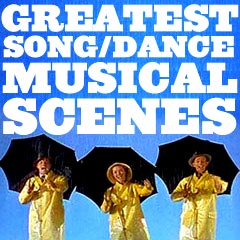
|
Musical Moments and Scenes W |
| W | ||
| Movie Title/Year and Scene Descriptions | ||
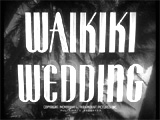
|
Waikiki Wedding (1937)
Paramount Pictures and director Frank Tuttle's lightweight musical comedy was a showcase for the extolment of Hawaii as a romantic destination (although most of the film was made in studios, there were a few background location shots). Its plot was also deliberately similar to many of the Astaire-Rogers hits of the Depression-Era. Bing Crosby starred as Tony Marvin, a lazy beach-bum PR agent for J. B. Todhunter's (George Barbier) Imperial Pineapple Company. His co-stars were Shirley Ross (as Georgia Smith, the winner of the company's "Pineapple Girl" contest, with a trip to Hawaii for "three weeks of romance") and comedienne Martha Raye (as Myrtle Finch, Georgia's friend). Due to Georgia's dissatisfaction with Hawaii, it became Tony's job to persuade her to stay, with romantic interest. There was also a separate sub-plot about a stolen, sacred black pearl. One of the film's best songs, Blue Hawaii, was used as the title song for Elvis Presley's Blue Hawaii (1961). It contained a number of memorable songs, one of which was honored with an Academy Award for Best Original Song (with music and lyrics by Harry Owen). The musical compositions included:
|
     
|

|
The Way We Were (1973)
Director Sydney Pollack's romantic melodrama won two musically-related Academy Awards: Best Original Dramatic Score (by Marvin Hamlisch) and Best Original Song for the title theme song. The title song was Barbra Streisand's first # 1 single in the US, and was the Grammy's Song of the Year. It was written by Hamlisch, with lyrics by Alan and Marilyn Bergman. It featured two superstars in their prime (told in flashback), as two mis-matched individuals over a lengthy period of time, stretching from their college days through the war years, to the post-war period, during which time they were married and divorced:
The title song (heard in the background during the opening credits) was reprised in the final sequence (a bittersweet ending when the two met up again after many years) and during the closing credits:
|
  
|

|
Wayne's World (1992) Director Penelope Spheeris' crazy comedy featured the original characters (spun-off and extended from a sketch on TV's Saturday Night Live) - two metal-head friends with their own local public-access TV show (broadcast from their wood-paneled basement) in Aurora, Illinois ("a suburb of Chicago - excellent"):
Their energetic Bohemian Rhapsody (pictured) was originally a song written by Freddie Mercury and recorded by his rock group Queen; it was performed as a sing-a-long by Wayne, Garth, and a group of friends in Wayne's Mirth-mobile: ("Thunderbolts and Lightning, Very Very Frightening"). |

|

|
Week-End in Havana (1941) Director Walter Lang's romantic comedy, released during the wartime years as another Fox Technicolored product, was taglined:
The 'south of the border' fantasy (with only the backdrops filmed in Cuba) starred:
The film's Latin stars were Carmen Miranda and Cesar Romero, both involved with a flashy Havana nightclub:
With her fruit-basket hat on her head, in the opening song-dance title number, A Week-End in Havana (pictured), Rosita invited everyone to meet her at "Sloppy Joe's." The tune was also often played throughout the film. |

|
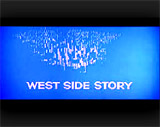
|
The tragic romance found in William Shakespeare's Romeo and Juliet was first adapted for the 1957 Broadway theatre stage. It possessed a great score by conductor/composer Leonard Bernstein and lyricist Stephen Sondheim, and staging/choreography by Jerome Robbins. The United Artists film version by co-directors Robert Wise and Jerome Robbins (for only a short time) was a multiple Oscar-winning film - and Best Picture, with some of the most famous and memorable ensemble song-and-dance numbers in film history. The film opened with a jaw-dropping aerial view of the city and then swooped down into the street for the opening song and dance sequence Jet Song (pictured) ("When you're a Jet / You're a Jet all the way"), one of two rival New York (Manhattan) West Side gangs:
The main stars were:
The most memorable musical numbers were:
The film ended with the choreographed gang fight that led to murders (first Bernardo's knifing of Riff, then Tony's killing of Bernardo and the retaliatory shooting death of Tony by Chino (Jose DeVega), Bernardo's best friend), and a reprise of the tune of Somewhere (pictured twice), sung by Maria as she knelt by Tony's body. |
         
|
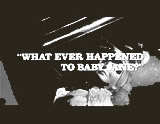
|
What Ever Happened to Baby Jane? (1962) In this grotesque Grand Guignol melodrama from director Robert Aldrich, two legendary screen rivals dueled onscreen:
In one of the film's most memorable scenes, "Baby Jane" was garishly dressed up as a little girl, practicing and croaking I've Written a Letter to Daddy (pictured often) while dressed in a baby-doll suit (with her hair in golden curly locks) to corpulent, impoverished, gigolo pianist and musical director Edwin Flagg (Oscar-nominated Victor Buono in his film debut). |
  
|
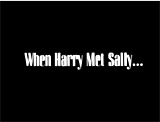
|
When Harry Met Sally... (1989)
Rob Reiner's popular romantic comedy from a Nora Ephron's script told about the over one-decade long friendship/relationship between journalist Sally Albright (Meg Ryan) and political consultant Harry Burns (Billy Crystal). It also attempted to answer the question: "Can a man and a woman be friends without sex becoming an issue?" The film's theme song was It Had to Be You, written by Isham Jones with lyrics by Gus Kahn, first published in 1924, and recorded numerous times by many artists. In the last memorable scene, Harry was dejected and walking the streets of New York by himself on New Year's Eve. He found himself under the Washington Square Arch where Sally had dropped him off after their car ride - twelve years earlier. In a voice-over flashback during a montage of images, he imagined their earlier conversation about how "the sex part always gets in the way" of a friendship between men and women. Suddenly he began to frantically run down the street (to the tune of Frank Sinatra's version of It Had to Be You (pictured)) toward a hotel's crowded New Year's Eve party where he finally breathlessly reached Sally, who had ditched her date and had decided to leave before midnight. He told her: "The thought of not kissing somebody is just..." He professed his undying love for her, as the countdown to the New Year and the playing of Auld Lang Syne (pictured) occurred in the background:
Sally melted: "You see. That is just like you, Harry. You say things like that, and you make it impossible for me to hate you, and I hate you, Harry. I really hate you. I hate you." They kissed often as the camera pulled up and away from them, showing them engulfed by others on the dance floor. |
   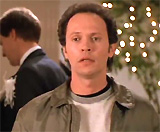 
|

|
White Christmas (1954) This perennial holiday favorite has been one of the highest-grossing musicals of all time. Directed by Michael Curtiz, it was Paramount's very successful follow-up to its popular Holiday Inn (1942). It was noted as being the studio's first VistaVision widescreen production. This heartwarming romantic comedy was filled with Irving Berlin songs (such as Blue Skies and a new version of White Christmas, that had already been introduced by Bing Crosby in Holiday Inn (1942)). The sole Oscar nomination was for Best Song: White Christmas. Its four main stars were a set of male and female performers - nightclub entertainers/producers (and war veterans) and a singing-sister act:
The plot was set after the war in the Columbia Inn, a Pine Tree, Vermont lodging place, with a "making a show" theme - a Christmas Eve benefit for Crosby's and Kaye's ex-veteran commanding Major General Thomas F. Waverly (Dean Jagger) - the owner/manager of the struggling and financially-failing Vermont hotel! Its most memorable moments included:
|
       
|

|
White Nights (1985)
Director Taylor Hackford's dramatic dance film, with a strong dose of international political intrigue, starred three significant individuals from the world of dance:
Both Hines and Baryshnikov came into contact with each other during the preposterous plot set in a remote area of Siberia (the land of the 'midnight sun' or white nights). They shared a highly-synchronized dance scene together to the tune of Prove Me Wrong (pictured) on the soundtrack (performed by David Pack). Baryshnikov also performed 11 pirouettes as a challenge from Hines, during the playing of Lou Reed's My Love is Chemical (pictured). Baryshnikov expressively danced solo on an empty stage (pictured), while Hines tap-danced solo (pictured) throughout the dance studio. The pair also warmed up for dance practice, to the tune of Jenny Burton's People Have Got to Move (pictured). The film's Oscar-winning Best Original Song, Say You, Say Me, was written and performed by Lionel Richie, during the rolling end credits. Another of the movie's songs, Separate Lives (Love Theme from White Nights) (written by Stephen Bishop and performed by Phil Collins and Marilyn Martin) was also nominated in the same category. |
     |

|
Who Framed Roger Rabbit (1988) Director Robert Zemeckis' award-winning animated-live action feature was a tribute and parody of detective noirs of the '40s. This landmark film featured the femme fatale character of sultry animated Toon character Jessica Rabbit (Kathleen Turner, singing voice by Amy Irving).
The film also contained:
|
   
|
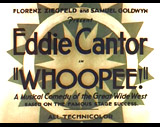
|
Whoopee! (1930) The musical comedy by director Thornton Freeland was adapted from Flo Ziegfeld's 1928 Broadway spectacular stage show of the same name. This revival of the stage production was significant as Samuel Goldwyn's first musical. Due to its success, it was remade by Goldwyn Studios as Up in Arms (1944), with their new "Eddie Cantor" star - Danny Kaye. The two-color Technicolored feature was also choreographer Busby Berkeley's first production, and it received one Academy Award nomination for Best Art Direction. The star of the film was Eddie Cantor, appearing as ranch worker and hypochondriac Henry Williams, whose love interest was long-suffering nurse Mary Custer (Ethel Shutta). The other female star was Eleanor Hunt as white heiress Sally Morgan, a ranch hand's daughter who was in love with Wanenis (Paul Gregory) of suspected Indian racial origin (a fact that stymied their affair). It featured Berkeley's first use of his innovative, trademarked overhead shots, especially in:
It also included hit songs, such as:
|
     
|
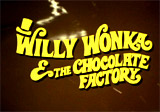
|
Willy Wonka & the Chocolate Factory (1971) The character of Willy Wonka - derived from Roald Dahl's children's books, was adapted for the screen in this film by director Mel Stuart, with Gene Wilder starring as the title character. Early in this cult classic was the first rendition of The Candy Man - sung by candy store owner Bill (Aubrey Woods):
[Note: Sammy Davis Jr.'s adaptation of the song became an all-time best selling hit.] Other memorable musical numbers included:
The fantasy musical film also included Wonka's strange, foreboding song Wondrous Boat Ride during the darkly morbid chocolate river-boat scene:
|
    
|

|
The Wiz (1978) This multi-million dollar, funked-up urban retelling of the MGM musical The Wizard of Oz (1939) was by director Sidney Lumet (his first musical) and Universal Pictures. Adapted from the long-running 1975 black Broadway stage version, and originally from L. Frank Baum's classic novel The Wonderful Wizard of Oz, it was generally poorly received, although it had four Academy Award nominations (with no wins):
It was filmed at the 1964 World's Fair grounds, the World Trade Center (which served as the Emerald City), and other locales in NY (Oz was a run-down New York slum!). Its main characters were pop stars (mostly miscast):
The film was best known for the songs and performances of:
|
   
|
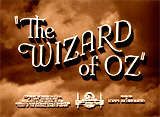
|
One of the most famous MGM screen musicals (reissued in 1948 and 1954, and with a TV debut in 1956), this family film musical with universal appeal was adapted from L. Frank Baum's children's stories of the magical land of Oz - woven together with E.Y. ("Yip") Harburg-Harold Arlen songs. Of its five Oscar nominations, it won two Awards: Best Musical Score and Best Original Song. Victor Fleming was the film's major director, and 16 year-old Judy Garland took the role of Kansas farm girl Dorothy Gale - launching herself into stardom. This beloved and enchanting film featured Garland's iconic tremulous, and melancholy performance of the Oscar-winning Best Song: (Somewhere) Over the Rainbow (pictured) during the sepia-toned opening segment, also the oft-repeated We're Off to See the Wizard (pictured) down the Yellow Brick Road ("To Oz? To Oz! Weeeeee're off to the see the Wizard, the Wonderful Wizard of Oz!..."). Other memorable songs included:
|
       
|

|
The Woman in Red (1984)
Actor/director/co-scriptwriter Gene Wilder's PG-13 rated romantic comedy was an adaptation or remake of director Yves Robert's French comedy farce Pardon Mon Affaire (1976, Fr.) (aka An Elephant Can Be Extremely Deceptive, or Un éléphant ça trompe énormément). The film's premise was also similar to Blake Edwards' 10 (1979) with Bo Derek and Dudley Moore. It told about Theodore "Ted" Pierce (Wilder) - a married ad agency executive in San Francisco who experienced a mid-life crisis after lustfully viewing the title character, a sexy woman in a red silk dress named Charlotte (supermodel Kelly Le Brock in her screen debut) in a Seven Year Itch (1955)-like pose within a parking garage (a la Marilyn Monroe atop a grating when her white dress blew up). Singer Stevie Wonder's un-nominated musical score (pictured) included the Oscar-winning Best Original Song I Just Called to Say I Love You - the film's sole nomination, that was sung by Wonder and played during the closing credits (pictured). |
 
|

|
Wonder Boys (2000, US/Germ./UK/Jp.)
Director Curtis Hanson's quirky comedic drama starred Michael Douglas as Professor Grady Tripp, a marijuana-toking author and philandering creative writing teacher at a Pittsburgh university, with students who included James Leer (Tobey Maguire) and Hannah Green (Katie Holmes). The soundtrack featured music from classic 60s performers, including Buffalo Springfield, Neil Young, Tim Hardin, Leonard Cohen and Van Morrison. The main featured artist was Bob Dylan, whose music resonated with the film's themes. Although nominated for three Academy Awards (including Best Film Editing and Best Adapted Screenplay), the movie won only one Oscar:
|
 |

|
Woodstock - 3 Days of Peace & Music (1970) Michael Wadleigh's landmark concert film documented the famous three day music concert-festival in the summer of 1969. It featured - sometimes in innovative split-screen technique - performances by:
|
  
|

|
Words and Music (1948) This dramatic biographical MGM fantasy musical (by director Norman Taurog) told about the disintegrating lives of songwriters Richard Rodgers (Tom Drake) and Lorenz Hart (Mickey Rooney), in a somewhat fictional account. There were three other similar MGM music-related biopics at the time about Broadway composers:
The film advertised its star-studded cast: "14 Sensational Stars! 22 Terrific Tunes! 14 Production Scenes! 5 Musicals in One!" Many of the performers appeared as themselves: June Allyson, Judy Garland, Lena Horne, Gene Kelly, Mel Torme, Vera-Ellen, Dee Turnell and The Blackburn Twins. And it was the last film of Rooney and Garland in which they appeared together. Some of the featured song performances were:
|
     
|
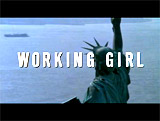
|
Working Girl (1988)
Director Mike Nichols' Best Picture-nominated modern farcical romantic comedy was about the workplace and challenges of being a working girl. The main characters were:
It began (during the opening title credits) with a breathtaking, rotating opening shot of the Statue of Liberty from the Staten Island ferry, as the Oscar-winning song Let the River Run (pictured twice) played (performed by singer/songwriter Carly Simon). It was the only Oscar category won by the film (from a total of six nominations). The film also ended with a brilliant final pull-back shot of Tess in her office, revealing her office to be just one of thousands in a single Manhattan building in the whole of New York City, as the subtly subversive lyrics of Let the River Run (also pictured twice) undercut the triumphant moment:
|
   
|
(alphabetical by film title) Introduction | A-1 | A-2 | B-1 | B-2 | B-3 | C-1 | C-2 | D-1 | D-2 | E | F-1 | F-2 | G-1 | G-2 H-1 | H-2 | I-J | K | L-1 | L-2 | M-1 | M-2 | N-O | P-1 | P-2 | R-1 | R-2 | S-1 | S-2 | S-3 | T | U-V | W | X-Z |